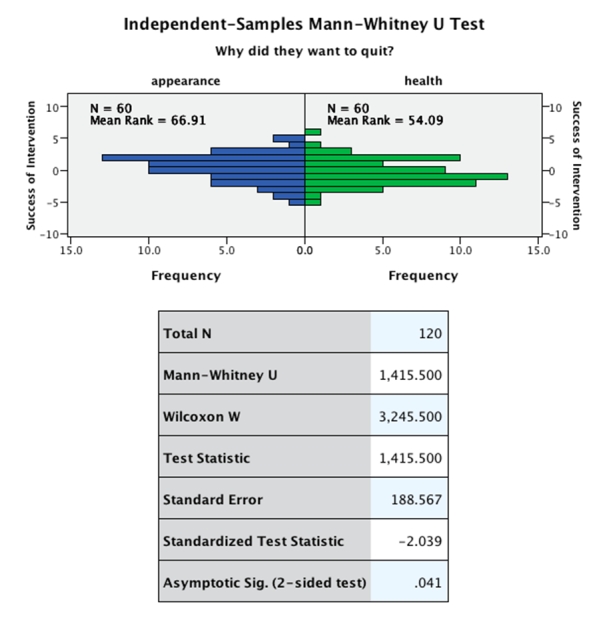Multiple Choice
Imagine we wanted to investigate whether the reason for quitting smoking affects success rate. We recruited a sample of 120 smokers. Half wanted to quit to improve their appearance (yellow teeth and bad breath, etc.) , and half wanted to quit to improve their health (life expectancy, etc.) . After six months we measured how successful they had been at quitting smoking. The data were skewed so we ran a Wilcoxon rank-sum test on the data (output below) . Which of the following sentences correctly reports the results from the Wilcoxon rank-sum test?
A) People who wanted to quit smoking to improve their health were significantly more successful at quitting than those who wanted to quit to improve their appearance, Ws = 3245.5, z = -2.04, p = .04.
B) People who wanted to quit smoking to improve their appearance were significantly more successful at quitting than those who wanted to quit to improve their health, T = -2.04, z = 188.57, p < .05.
C) This output relates to the Mann-Whitney test and tells us nothing about the Wilcoxon rank-sum test.
D) People who wanted to quit smoking to improve their appearance were significantly more successful at quitting than those who wanted to quit to improve their health, Ws = 3245.5, z = -2.04, p = .04.
Correct Answer:

Verified
Correct Answer:
Verified
Q1: The _ and _ tests are calculated
Q3: What is the Kruskal-Wallis test based upon?<br>A)Ranks<br>B)Means<br>C)Intervals<br>D)Residuals
Q4: A psychologist was interested in whether there
Q5: What symbol represents the test statistic for
Q6: Which of the following tests would you
Q7: What is the non-parametric equivalent of the
Q8: When the groups have equal numbers of
Q9: What is the problem with doing multiple
Q10: Non-parametric tests are used when:<br>A)The assumptions of
Q11: You have carried out a Kruskal-Wallis test.